Sarkar N. (ed.) Human-Robot Interaction
Подождите немного. Документ загружается.


Hand Posture Segmentation, Recognition and Application for Human-Robot Interaction
511
Figure 10. The epipolar geometry computed from the calibration matrices
a)
b)
Figure 11. (a) Segmentation results of one pair of calibrated hand images, (b) Extracted
matches and the estimated epipolar geometry
Our experimental results demonstrate the performance of the proposed algorithm. We first
use this algorithm to estimate the fundamental matrix between two calibrated cameras, and
compare the obtained epipolar geometry with that computed from the calibration matrices
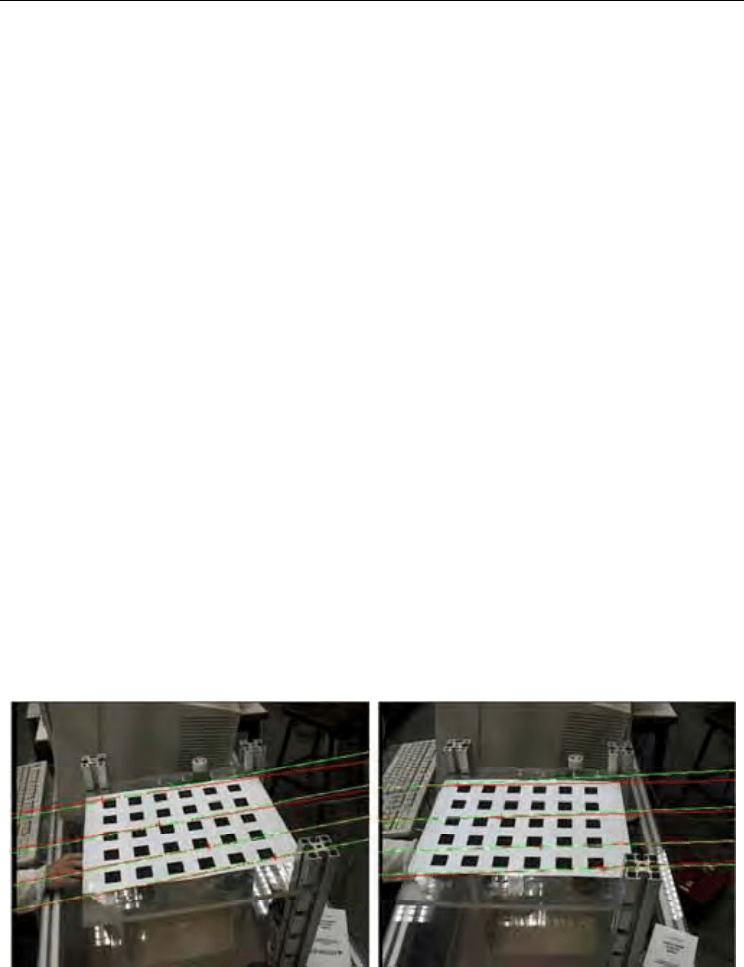
Human-Robot Interaction
512
of the cameras. The epipolar geometry computed from the calibration matrices is shown in
Fig. 10. It serves as a ground truth. Fig. 11 shows a pair of hand images taken by the
calibrated cameras with the size of 384 x 288. In that, (a) shows the segmentation results of
the hand images using the method presented in Section 2, and (b) shows the extracted
corresponding points using the approach presented in Section 3 as well as the epipolar
geometry estimated from these matches using the algorithm described in this section.
Sometimes, the matches extracted from the hand images may lie on a plane. This will cause
degeneracy in the data, and affect the accuracy of the estimation of the fundamental matrix.
We can take more hand images with the hand at different positions and use all the matches
extracted from these images to get a more accurate estimation of the fundamental matrix. The
epipolar geometry estimated using all the matches obtained from several hand images is
shown in Fig. 12. The red solid lines represent the epipolar lines estimated from the extracted
matches, and the green dash lines represent those computed from the calibration matrices. It
can be observed the estimated epipolar geometry is very closed to the calibrated one.
Fig. 13 shows a pair of hand images taken by two uncalibrated cameras with the size of 384
x 288. In that, (a) shows the segmentation results of the hand images and (b) shows the
extracted corresponding points as well as the epipolar geometry estimated from these
matches. In order to avoid the problem of degeneracy, and obtain more accurate and robust
estimation of the fundamental matrix, we take more than one pairs of hand images with the
hand at different positions, and use all the matches found in these images to estimate the
fundamental matrix. Fig. 14 shows another pair of images taken by the same cameras, where
the epipolar geometry is estimated from all the matches obtained from several hand images.
It can be observed that the estimated epipolar lines match the corresponding points well
even though there is no point in this figure used for the estimation of the fundamental
matrix. So at the beginning of hand gesture recognition, we can take several hand images
with the hand at different positions, and use the matches extracted from these images to
recovery the epipolar geometry of the uncalibrated cameras. Then the recovered epipolar
geometry can be applied to match other hand images and reconstruct hand postures. If the
parameters of the cameras change, the new fundamental matrix is easy to be estimated by
taking some hand images again.
Figure 12. Comparison of the estimated epipolar geometry with the calibrated one
In [Zhang et al., 1995], Zhang proposed an approach to match images by exploiting the
epipolar constraint. They extracted high curvature points as points of interest, and match

Hand Posture Segmentation, Recognition and Application for Human-Robot Interaction
513
them using a classical correlation technique followed by a new fuzzy relaxation procedure.
Then the fundamental matrix is estimated by using a robust method: the Least Median of
Squares (Lmeds). Zhang provides a demo program to compute the epipolar geometry
between two perspective images of a single scene using this method at his home page:
http://www.inria.fr/robotvis /personnel/zzhang/zzhang-eng.html. We submitted the
images in Figs. 13 and 14 to this program and obtain the results as shown in Figs. 15 and 16,
where (a) shows the extracted correspondences which are marked by white crosses, and (b)
shows the estimated epipolar geometry. It can be seen the epipolar lines are very far from
the corresponding points on the hand.
The approach presented in this section can also be used for other practical applications. For
example, at some occasions when the calibration apparatus is not available and the feature
points of the scene, such as corners, are difficult to be extracted from the images, we can take
advantage of our hands, and use the method presented above to derive the unknown
epipolar geometry for the uncalibrated cameras. This method is described in more detail in
our paper [Yin and Xie, 2003].
a)
b)
Figure 13. (a) Segmentation results of one pair of uncalibrated hand images, (b) Extracted
matches and the estimated epipolar geometry
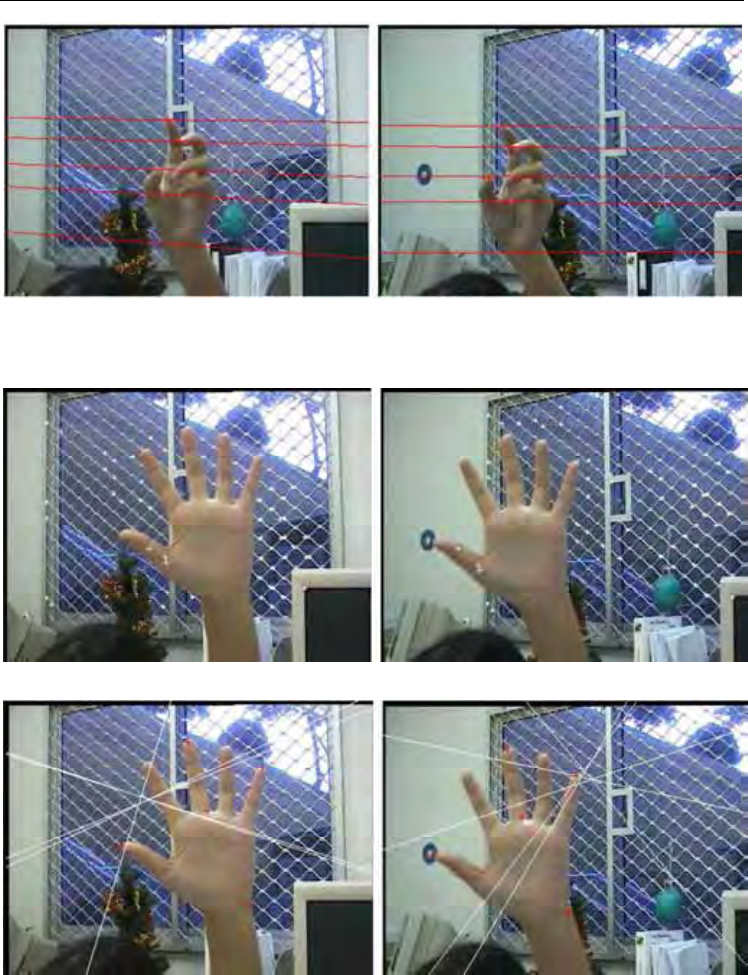
Human-Robot Interaction
514
Figure 14. Application of the estimated epipolar geometry to one pair of uncalibrated hand
images
a)
b)
Figure 15. (a) Extracted matches using the method proposed by Zhang from uncalibrated
hand images shown in Fig. 13, (b) Estimated epipolar geometry from these matches
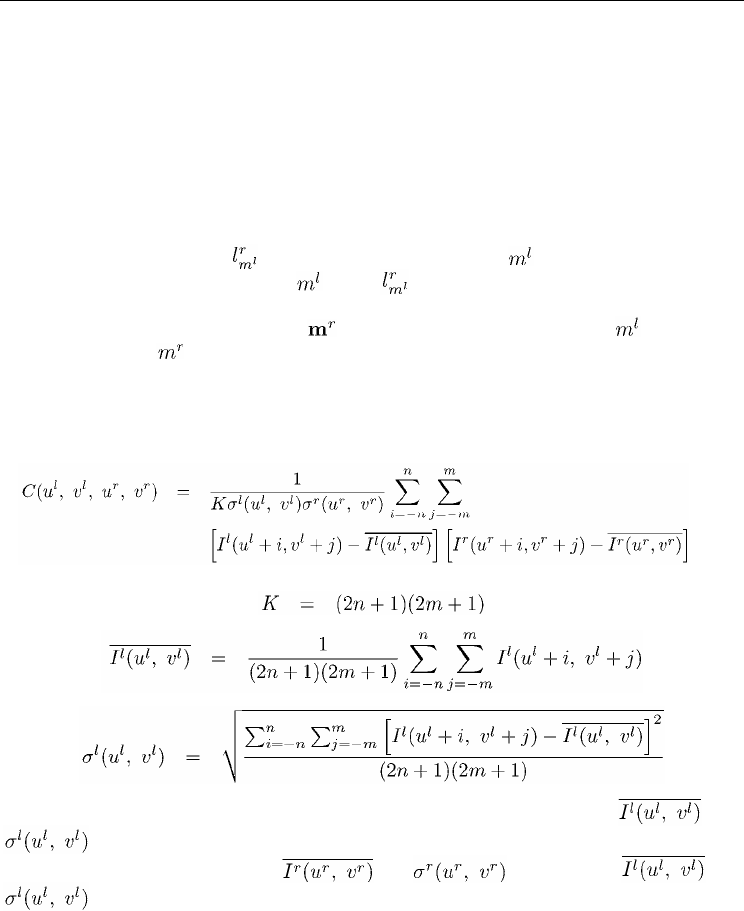
Hand Posture Segmentation, Recognition and Application for Human-Robot Interaction
515
4.3 Reconstruct hand postures
After the epipolar geometry between two uncalibrated cameras are recovered, it can be
applied to match other hand images and reconstruct 3D hand postures. Although stereo
images taken by uncalibrated cameras allow reconstruction of 3D structure only up to a
projective transformation, it is sufficient for hand gesture recognition, where the shape of
the hand, not the scale, is important.
The epipolar geometry is the basic constraint which arises from the existence of two
viewpoints. For a given point in one image, its corresponding point in the other image must
lie on its epipolar line. This is known as the epipolar constraint. It establishes a mapping
between points in the left image and lines in the right image and vice versa. So, if we
determine the epipolar line
in the right image for a point in the left image, we can
restrict the search for the match of along . The search for correspondences is thus
reduced to a ID problem.
After the set of matching candidates is obtained, the correct match of in the right
image, denoted by
, is further determined using correlation-based method. In correlation-
based methods, the elements to match are image windows of fixed size, and the similarity
criterion is a measure of correlation between windows in two images. The corresponding
element is given by the window that maximizes the similarity criterion within a search region.
For intensity images, the following cross-correlation is usually used [Faugeras, 1993]:
(13)
with
(14)
(15)
(16)
where, I
1
and I
r
are the intensity functions of the left and right images. and
are the mean intensity and standard deviation of the left image at the point (u
l
, v
l
)
in the window (2n + 1) x (2m + 1).
and are similar to and
, respectively. The correlation C ranges from -1 for two correlation windows
which are not similar at all, to 1 for two correlation windows which are identical. However,
this cross-correlation method is unsuitable for color images, because in color images, a pixel
is represented by a combination of three primary color components (R (red), G (green), B
(blue)). One combination of (R, G, B) corresponds to only one physical color, and a same
intensity value may correspond to a wide range of color combinations. In our method, we
use the following color distance based similarity function to establish correspondences
between two color hand images [Xie, 1997].
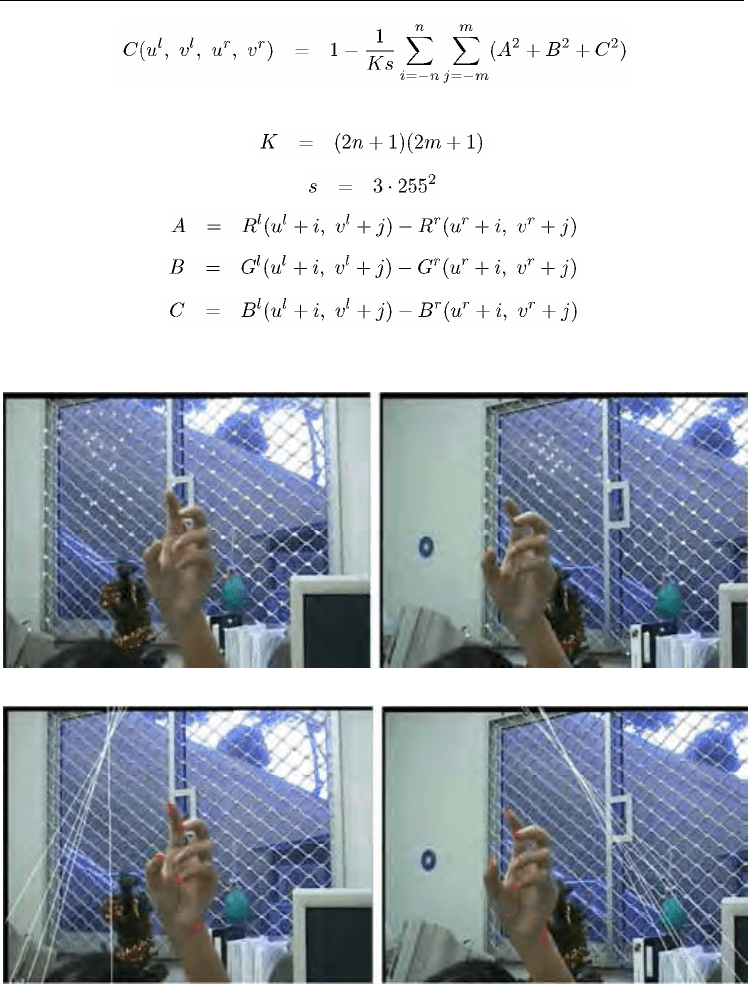
Human-Robot Interaction
516
(17)
with
(18)
(19)
(20)
(21)
(22)
where, R
l
, G
l
and B
l
are the color values of the left image corresponding to red, green and
blue color components, respectively. R
r
, G
r
and B
r
are those of the right image.
a)
b)
Figure 16. (a) Extracted matches using the method proposed by Zhang from uncalibrated
hand images shown in Fig. 14, (b) Estimated epipolar geometry from these matches
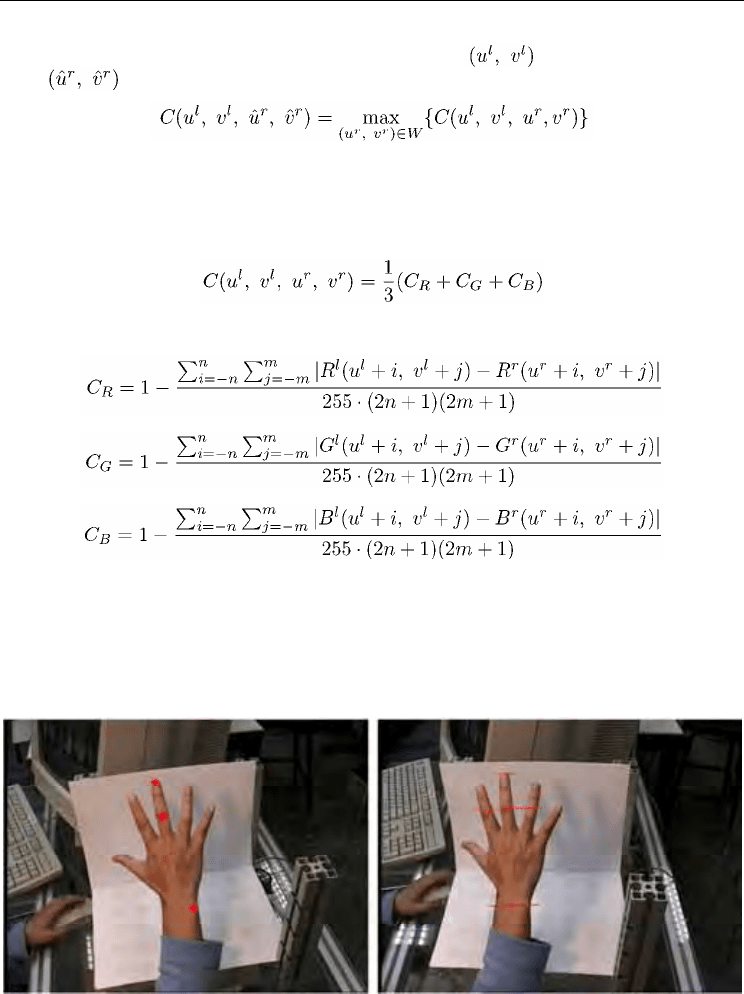
Hand Posture Segmentation, Recognition and Application for Human-Robot Interaction
517
The similarity function defined in Equation (17) varies in the range [0, 1]. Then stereo
matching can be summarized as follows: Given a pixel
in the left image, find a
pixel
in the right image which maximizes the similarity function in Equation (17):
(23)
where, W denotes the searching area in the right image. In our implementation, the
searching area is limited in the segmented hand region and on the epipolar line.
The computation of C is time consuming because each pixel involves three multiplications.
In practice, a good approximation is to use the following similarity function.
(24)
where
(25)
(26)
(27)
The similarity function defined in Equation (24) also takes values in the range [0, 1].
As shown in Figure 17, for the points marked by red crosses in the left image, their matching
candidates in the right image found by the technique described above are marked by red
points. Figure 18 shows all detected corresponding points of the hand, and Figure 19 shows
4 views of the reconstructed 3D hand posture.
Figure 17. Find corresponding points in the right image which are marked by red points, for
points in the left image which are marked by red crosses, using the color correlation and
epipolar geometry
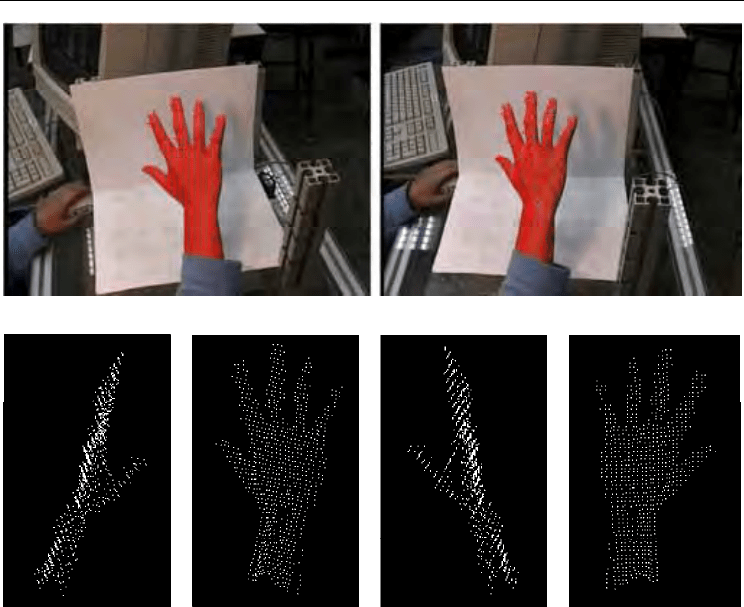
Human-Robot Interaction
518
Figure 18. Detected corresponding points of the hand
(a) Right view (b) Front view (c) Left view (d) Back view
Figure 19. Different views of the reconstructed 3D hand posture
5. Gesture-Based Human-Robot Interaction
Our research on hand gesture recognition is a part of the project of Hybrid Service Robot
System, in which we will integrate various technologies, such as real robot control, virtual
robot simulation, human-robot interaction etc., to build a multi-modal and intelligent
human-robot interface. Fig. 20(a) shows the human-alike service robot HARO-1 at our lab. It
was designed and developed by ourselves, and mainly consists of an active stereo vision
head on modular neck, two modular arms with active links, an omnidirectional mobile base,
dextrous hands under development and the computer system. Each modular arm has 3
serially connected active links with 6 axes, as shown in 20 (b).
5.1 Gesture-Based Robot Programming
In order to carry out a useful task, the robot has to be programmed. Robot programming is
the act of specifying actions or goals for the robot to perform or achieve. The usual methods
of robot programming are based on the keyboard, mouse and teach-pendant [Sing and
Ikeuchi, 1997]. However, service robots necessitate new programming techniques because
they operate in everyday environment, and have to interact with people that are not

Hand Posture Segmentation, Recognition and Application for Human-Robot Interaction
519
necessarily skilled in communicating with robots. Gesture-based programming offers a way
to enable untrained users to instruct service robots easily and efficiently.
a) b)
Figure 20. (a) Humanoid service robot HARO-1; (b) Modular robot arm with 6 axes
Based on our approach of 2D hand posture recognition, we have proposed a posture
programming method for our service robot. In this method, we define task postures and
corresponding motion postures respectively, and associate them during the training
procedure, so that the robot will perform all the motions associated with a task if that task
posture is presented to the robot by the user. Then, the user can interact with the robot and
guide the behavior of the robot by using various task postures easily and efficiently.
The postures shown in Fig. 6 is used for both robot programming and human-robot
interaction. In the programming mode, Postures a to f represent the six axes of the robot arm
respectively, Posture g means 'turn clockwise', and Posture h means 'turn anti-clockwise'.
We use them as motion gestures to control the movements of the six axes of either robot
arm. Using these postures, we can guide the robot arm to do any motion, and record any
motion sequence as a task.
In the interaction mode, these postures are redefined as task postures and associated with
corresponding tasks. For example, some motion sequence is defined as Task 1, and is
associated with Posture a. When Posture a is presented to the robot in the interaction stage,
the robot will move its arm according to the predefined motion sequence. A task posture is
easy to be associated with different motion sequences in different applications by
programming using corresponding motion postures.
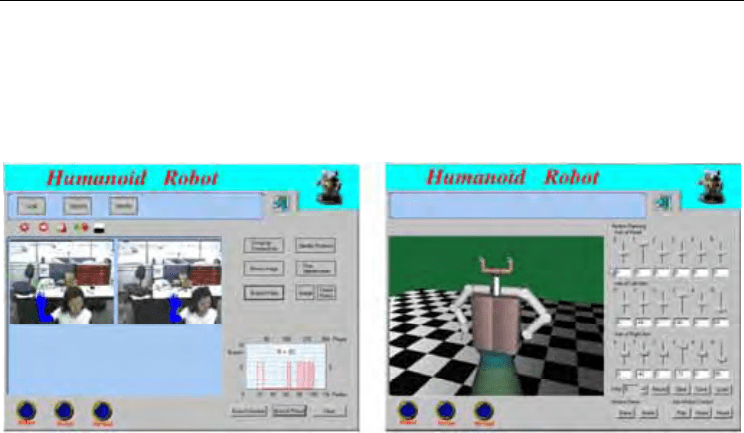
Human-Robot Interaction
520
5.2 Gesture-Based Interaction System
Fig. 21 shows the Graphic User Interface (GUI) of the gesture-based interaction system
implemented on robot HARO-1, in that (a) represents the Vision section of the interface, and
(b) shows the virtual robot developed using Open GL.
a) b)
Figure 21. Graphic user interface of the robot HARO-1: (a) Posture recognition; (b) Virtual
robot
As shown in Fig. 21 (a), live images with the size of 384x288 are captured through two CCD
video cameras (EVID31, SONY) in the system. At the end of each video field the system
processes the pair of images, and output the detected hand information. The processing is
divided into two phases: hand tracking phase and posture recognition phase. At the
beginning, we have to segment the whole image to locate the hand, because we have no any
information about the position of the hand. After the initial search, we do not need to
segment the whole image, but a smaller region surrounding the hand, since we can assume
continuity of the position of the hand during the tracking. At the tracking phase, the hand is
segmented using the approach described in Section 2 from a low resolution sampling of the
image, and can be tracked reliably at 4-6Hz on a normal 450MHz PC.
The system also detects the motion features of the hand such as pauses during the tracking
phase. Once a pause is confirmed, the system stops the tracking, crops a high resolution
image tightly around the hand and performs a more accurate segmentation based on the
same techniques. Then the topological features of the hand is extracted from the segmented
hand image and the hand posture is classified based on the analysis of these features as
described in Section 3. If the segmented hand image is recognized correctly as one of the
postures defined in Fig. 6, the robot will perform motions associated with this posture. If the
segmented image can not be recognized because of the presence of noises, the robot will not
output any response. The time spent on the segmentation of the high resolution image is less
than 1 second, and the whole recognition phase can be accomplished within 1.5 seconds.
After the posture recognition phase is finished, the system continues to track the hand until
another pause is detected.
